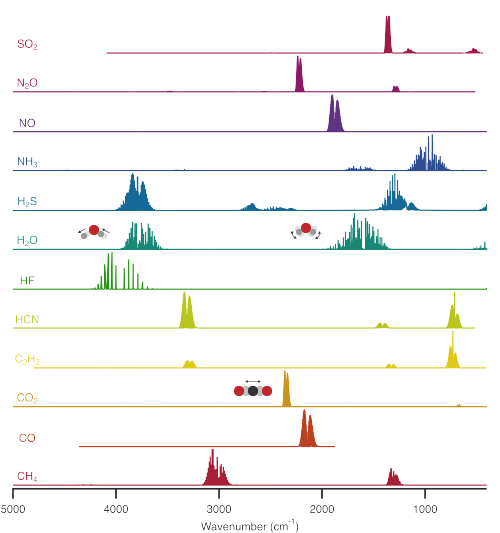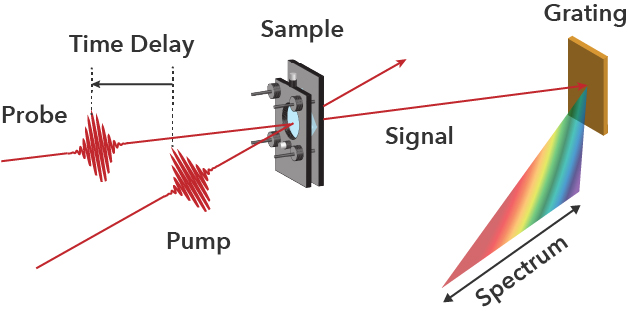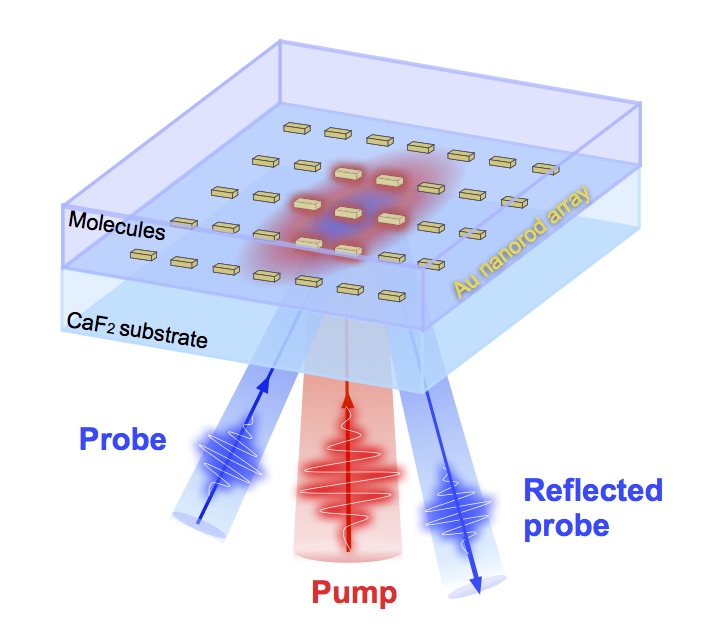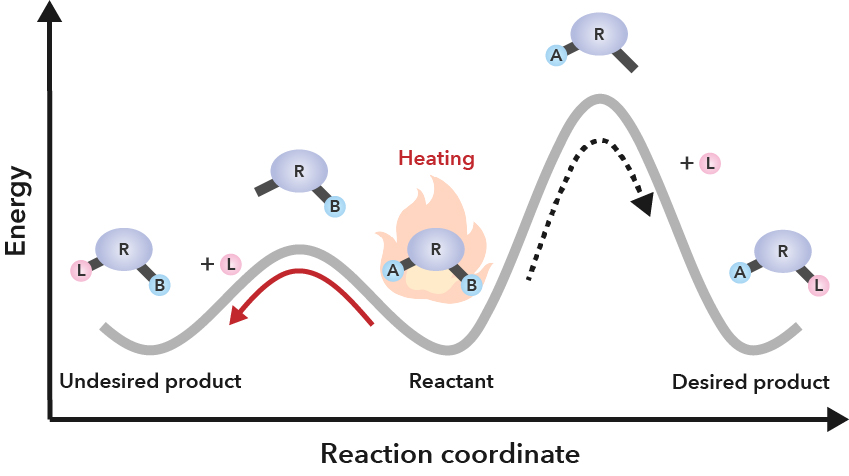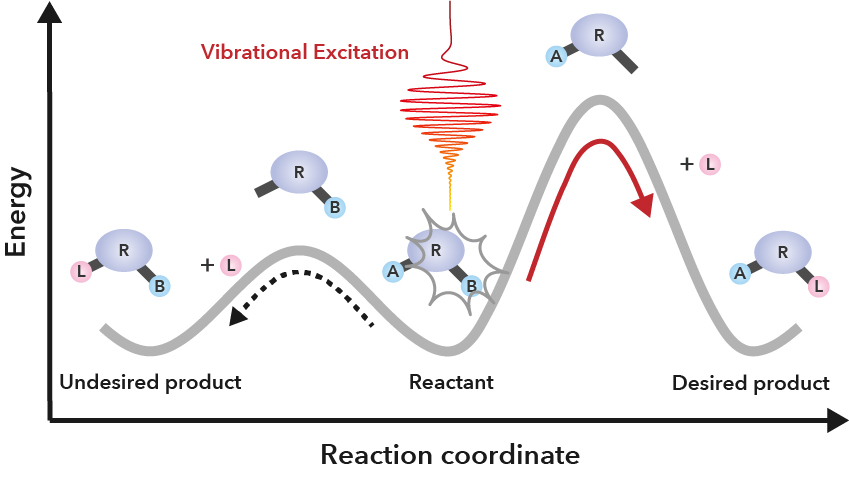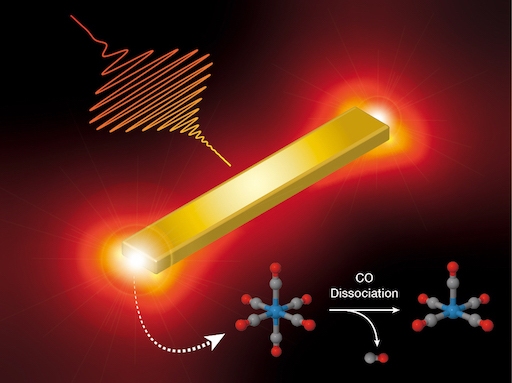はじめに / Introduction
物質を原子・分子レベルで観測・制御することは、現代科学における大きな目標の一つです。赤外光は分子の振動を直接励起できるという性質を持っており、分子の構造を捉えたり反応を操作したりする上で優れた潜在能力を秘めています。芦原研究室では、赤外超短パルスレーザーを始めとする様々な光技術を駆使した新規分子計測・制御手法の創出に取り組んでいます。
The observation and control of matter at the atomic and molecular level is one of the major goals of modern science. Infrared light can directly excite molecular vibrations, which enables us to investigate molecular structures and to control chemical reactions. We are developing novel molecular measurement and control methods utilizing state-of-the-art optical technologies including infrared ultrashort pulsed lasers.
振動分光法 / Vibrational Spectroscopy
分子は2つ以上の原子が結合してできており、構成原子の質量と結合強度で決まる固有の振動数を持っています。この固有振動数の情報から分子の構造を探る手法が振動分光法です。
Molecules have vibrational modes, whose eigenfrequencies determined by the mass of the constituent atoms and bond strength. Vibrational spectroscopy is a technique for investigating the structure of molecules based on information on these eigenfrequencies.
一般に、分子の固有振動数は中赤外光の周波数領域にあります。よって、分子に赤外光を照射して透過光の強度を周波数ごとに測定すると、分子の固有振動数と一致する周波数の光が吸収されます(図1)。このようにして得られた振動スペクトルは、いわば「分子の指紋」であり、分子の種類によって全く異なる形状を示すため、分子の構造解析や分子種の同定に役立ちます(図2)。
In general, the eigenfrequencies of molecular vibrations are in the frequency range of mid-infrared light. When a molecule is irradiated with infrared light and the intensity of the transmitted light is measured for each frequency, light with a frequency that matches the eigenfrequency is absorbed (Fig. 1). The vibrational spectra show identical shapes of molecules, which is useful for structural analysis and identification of molecular species (Fig. 2).
今日では、振動分光法は基礎研究だけでなく、材料・食品・医薬などの分野の研究開発で幅広く利用されています。近年、赤外レーザー光源技術の発展と相まって、レーザーの持つ空間コヒーレンスを活かしたイメージング分光や、直進性を活かしたリモートセンシング、さらには、2台の繰り返し周波数の異なる赤外超短パルスレーザーを用いたデュアルコム分光などの研究が盛んに行われています。芦原研究室では、赤外超短パルスレーザーの持つ高いコヒーレンス性と、重力波検出などでも用いられている干渉系の技術を駆使して、これまでにない高感度な振動分光法の創出に取り組んでいます。
Nowadays, vibrational spectroscopy is widely used not only for basic research but also for research and development in fields such as materials, food, and medicine. In recent years, the advent of infrared laser techniques has enabled imaging, remote sensing, and dual-comb spectroscopy. In our group, we are developing novel vibrational spectroscopy for trace gas sensing.
超高速振動分光法 / Ultrafast Vibrational Spectroscopy
分子が化学反応を起こし、結合が切断されたり生成されたりする時間スケールはとても速く(100フェムト秒程度)、通常の手法では観測できません。このような速い現象を捉える手法が、ポンプ・プローブ分光法に代表される超高速分光法です。
The time scales of elementary reactions such as bond breaking and making are so fast (about 100 femtoseconds) that they cannot be observed using conventional techniques. Ultrafast spectroscopy, such as pump-probe spectroscopy, is a powerful method to observe such fast phenomena.
ポンプ・プローブ分光法では、ポンプ光パルスによって誘起された物質の構造・状態変化をプローブ光パルスで測定することで、パルスの時間幅程度の時間分解分光が可能となります(図3)。
In pump-probe spectroscopy, ultrashort pulse sequences are used to excite and detect molecular vibrations, enabling time-resolved study of the molecular dynamics (Fig. 3).
In pump-probe spectroscopy, time-resolved spectroscopy of the pulse duration is possible by measuring the change in structure and state of a material induced by a pump light pulse with a probe light pulse.
超高速振動分光法は、分子の振動や化学反応のダイナミクスを捉える上で強力な手法ですが、この手法は非線形光学過程に基づいているため、感度に乏しいという欠点がありました。
この欠点を克服するため、私たちは赤外プラズモニクスの技術に着目しました。赤外域に共鳴を持つ金属ナノ構造に赤外超短パルスレーザーを照射すると、自由電子の共鳴的な集団振動(局在表面プラズモン)が励起され、金属表面に時間・空間の両面で局在化・高強度化された電磁場が生成されます。
私たちは、この増強場を利用することで、赤外超高速分光の感度を6-7桁向上させることに成功しました(図4)。この手法を使えば、単分子膜や少量分子を対象とする計測や、小型の光源を使った計測が可能になると期待されます[3-5]。
振動励起による化学反応制御 / Vibrational Control of Chemical Reactions
振動分光法では、分子の固有振動数と一致する周波数の光が吸収されるという特性を利用して、分子の構造を捉えていました。ここで吸収されたエネルギーは、分子の振動エネルギーに変換されます。この振動エネルギーを積極的に活用して、化学反応をコントロールする研究が近年注目されています。
In vibrational spectroscopy, molecules absorb infrared light with its eigenfrequencies. Here, the absorbed energy is converted into vibrational energy of the molecule. Recently, it has been attractive attention to control chemical reactions by actively utilizing this vibrational energy.
多くの化学反応が「分子を構成する原子の組み替え」であることを考えると、反応をコントロールするための鍵は「結合の切断」です。分子の結合を切るためには、その結合が関与する振動モードに活性化障壁以上のエネルギーを与える必要があります。
Given that many molecular reactions are recombination of constituent atoms, the key to controlling the reaction is bond breaking. Deposition of sufficient vibrational energy into a specific bond can lead to bond cleavage.
一般に、こうした反応を引き起こすために、物質を高温にするという方法がとられます。しかし、加熱によって与えた熱エネルギーは、反応に関与しないものも含む全ての振動モードに等しく分配される(エネルギー等分配則)ため、エネルギーが無駄になるだけでなく、場合によっては副反応も促進されてしまうという欠点があります(図5)。
In general, such reactions are driven by thermal activation. However, heating the molecules results in excitation of all vibrational modes (law of equipartition of energy), which not only wastes energy but also can accelerate side reactions (Fig. 5).
分子が持つ振動モードはそれぞれに固有の振動数を持っているため、赤外超短パルスレーザーの周波数を適切に選ぶことで、反応に関わる特定の振動モードだけにエネルギーを与えることができます(図6)。これにより、分子に与えるエネルギーを最小限にとどめつつ、目的とする反応だけを引き起こすことが可能となります。このようなアプローチは「分子手術」と呼ばれ、分子レベルで化学反応を自在にコントロールする究極的な手法の一つとして期待されています。
Infrared ultrashort laser pulses can directly excite a specific molecular vibration enabling us bond-selective control of chemical reactions (Fig. 6). This approach is called “molecular surgery,” and is expected to be one of the ultimate methods for controlling chemical reactions at the molecular level.
分子の結合を切るほどの振動エネルギーを与えることはそう簡単ではありません。特に溶液中では、分子に与えた振動エネルギーが溶媒分子との相互作用により減衰しやすいため、分子に効率よく振動エネルギーを与えるための工夫が必要です。
芦原研究室では、赤外超短パルスレーザーの電場波形を整形する技術と、光をナノメートルスケールの微小空間に集中させる技術(プラズモニクス)を駆使して、金属錯体分子の振動を強く励起し、溶液中で結合を切ることに成功しました[1]。この実験で分子に与えた振動エネルギーは、およそ18000Kの熱エネルギーに相当し、従来の加熱によるアプローチでは到達できない大きなエネルギーを特定の分子振動に与えることに成功しています。




